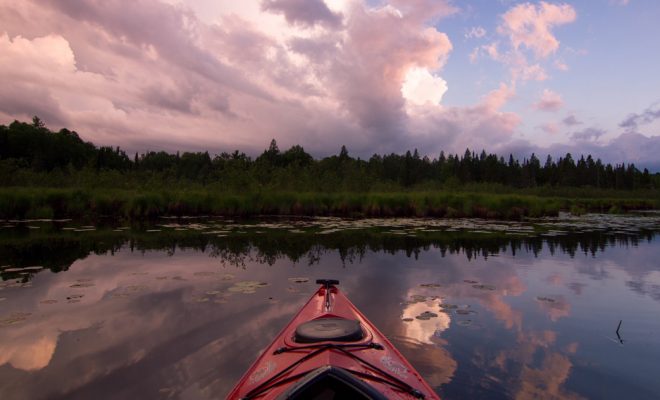Living on the Lake August Issue: New threat to Northwoods lakes

Presque Isle citizens group bands together to ban wake-enhancing watercraft
By Eileen Persike
Editor
Wisconsin’s first aquatic invasive species (AIS) management plan was introduced in 2003. Since that time, lake home owners and lake enthusiasts have been working to prevent, contain and control aquatic invasive species in effort to protect the waters for future generations.
A Presque Isle man believes there is a new and dangerous threat to northern Wisconsin lakes: wave-enhancing watercraft. Retired engineer and lake home owner Jeff Meessmann has joined with like-minded citizens to fight it.
The Last Wilderness Alliance (LWA) was formed in June 2021 to “conserve, enhance and protect natural resources and support the economic viability of the north Lakeland region,” according to the LWA website. As a member of Natural Lakes in Presque Isle, one of the largest home owners associations in the state, Meessmann had experience working to prevent wake boats from getting on the association’s four lakes.
“When LWA started up, I was recommended to help them work on the same thing,” Meessmann said. “They are working on all of Presque Isle to educate people on what the wake surfing boat is and the damage they can do.”
The group was initially established to address two things. A town of Presque Isle ordinance was recently passed by the town board allowing ATVs on all town roads; all, the group says, without public input. Secondly, and more important to Meessmann, was to move along a stalled hazardous wake ordinance.
“Wake-enhancing watercraft [WEW], also known as wake boats create a hazardous destructive wake from two to five feet high, behind which an individual may surf, ski, wake-board, wake jump, wake surf and the like,” Meessmann explained.
“We’re not talking about jets skis, or water skis or anything like that. Even wake boarding to a certain extent…What we’re really focusing on is a wake surfing boat.”
The larger, more destructive wave can be produced in a number of ways, including a ballast system in the back of the boat – pumping lake water into a bladder, to increase the boat’s water displacement, which enlarges the wake produced.
Another method uses mechanical hydrofoil, or a little flap that open up at the bottom of the boat to divert water to make the wave bigger. A third way would be for the user to operate the watercraft in a manner that would intentionally increase the size of the wave, such as adding people or rocks to the rear of the boat or driving very slowly to amplify the wave.
The problem with wake surfing boats on Northwoods lakes, compared to water ski boats and wakeboarding boats, is that WEW drive slowly, 10 miles an hour, and the prop is aimed down, some 48 inches into the water at a 40-degree angle. A wake surfing boat can turn over the bottom of a 200-acre lake in just 22 hours of boating time.
“While they’re doing that, they’re disrupting all the weeds that are supposed to be down there and all the fish habitat and everything,” Meessmann said. “When you think about a 200-acre lake [like those in Natural Lakes], that’s a long weekend. There’s not a lake in Presque Isle that’s big enough to entertain any of these boats.”
Meessmann pointed to Mid Lake in Woodruff, a fish hatchery for the chain of lakes that feeds Minocqua that he said is being destroyed by wake surfing boats.

Fall in Presque Isle Natural Lakes area.
“This is where all these baby fish are created; if they’re destroying the habitat and hatchery for these fish, they’re going to destroy the number of fish we can catch, too,” he said.
The domino effect of WEW endangers water quality, aquatic plants and wildlife, safety for other lake users, shorelines and can further the spread of AIS, Meessmann said.
Water quality
Plowing the lake bottom can lead to increased algae bloom and create re-suspension of sediment. Disturbed sediment contains phosphorus, which fertilizes algae blooms. The blooms die and decay, and in the process eat up the dissolved oxygen in the lake water, potentially killing the lake.
Aquatic plants and wildlife
The disturbed lake bottom also decreases water clarity, diminishing the availability of sunlight and nutrients to plants. Waves created by WEW can have a negative impact on fish, birds, amphibians, eggs, larva insects and other organisms through direct contact with the boat propellers or indirectly by the disturbed or destroyed habitat.
Safety
The wake created by WEW can be unsafe for other lake users, including people in canoes, kayaks, paddle boards, fishing or swimming. Meessmann said there have been near misses reported on Wildcat Lake, where a person in the water was not seen by the wake boat operator because the raised front of the boat obscured the driver’s view.
Shoreline
The two to five foot waves created by WEW can damage shorelines, piers, watercraft and shore stations and increase erosion.
Invasive Species
Because the ballast systems used in WEW cannot be emptied completely there is an increase in the probability of transmitting invasive species by transporting water from one lake to another.
There is an ordinance committee meeting in the community room or the pavilion at the town hall. Meessmann said the best case scenario would be for the committee to decide to pass Hazardous Wakes ordinance 507, which states in part, “The operation of a boat in a manner that intentionally magnifies its wake for recreation purposes such as wake boarding, wake surfing or wake jumping is prohibited on a lake or river within the township boundaries.”
People live in Presque Isle because of its pristine lakes, Meessmann said.
“Let’s work to keep Presque Isle lakes part of ‘Wisconsin’s Last Wilderness’ and prevent it from becoming ‘Wisconsin’s Lost Wilderness.’”
Leave a reply
You must be logged in to post a comment.






